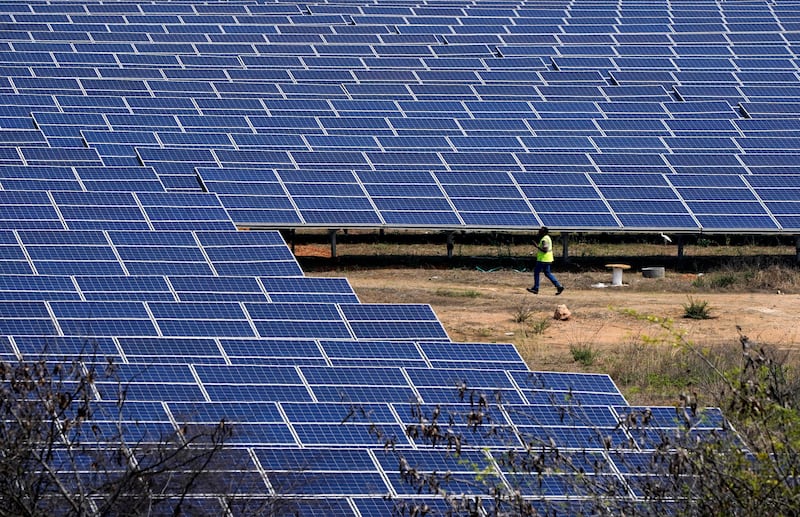Green hydrogen can play a crucial role in India's future energy plans as the country aims to become a global destination for the clean fuel.
However, hurdles will need to be overcome before hydrogen can be widely used across the country and exported, industry experts say.
Green or clean hydrogen is made using electrolysers powered by renewable energy to split water from oxygen.
Although hydrogen can play a potentially key role in the transition to sustainable energy, its use as a fuel is still at a nascent stage globally.
“If you consider from the point of view of India's quest for energy security, its global commitment to ensuring net zero by 2070, at the same time as emerging [as] a major emerging market economy, ensuring that the price of energy remains within reasonable limits, hydrogen offers an excellent method of storing of energy,” says Davinder Sandhu, co-founder and chairman of management consultancy Primus Partners.
Green hydrogen is seen as an effective way of storing renewable energy. India has been boosting its generation of power from clean sources in an effort to bring down its carbon emissions, reduce its dependence on expensive fossil fuel imports and meet the country's rising demand for energy.
Prime Minister Narendra Modi's government has ambitious plans for India to not just produce green hydrogen to meet its own needs, but also to become a global centre for production, exporting the fuel to other parts of the world.

“Renewable electricity sources are an important component in green hydrogen production and due to the regulatory policies and focus on net-zero goals, India has one of the fastest growing renewable energy capacities in the world,” says Bhargavi Vijayakumar, partner at Java Capital, a Bengaluru-based venture capital fund, with climate technology as one of its focus areas.
“India wants to capitalise on this capacity and double down on investments to become a major green hydrogen hub in the world.”
Earlier this year, India approved its National Green Hydrogen Mission, which includes an initial commitment of 197.44 billion rupees ($2.4 billion) towards pilot projects and research and development.
The mission's targets include developing an annual green hydrogen production capacity of 5 million metric tonnes, a reduction in fossil fuel imports by more than 1 trillion rupees, prevention of about 50 million metric tonnes of annual greenhouse ambitions and the creation of more than 600,000 jobs, according to India's Ministry of New and Renewable Energy.
“The mission will have wide ranging benefits — creation of export opportunities for green hydrogen and its derivatives, decarbonisation of industrial, mobility and energy sectors, reduction in dependence on imported fossil fuels,” according to the ministry.
To facilitate the sector, it says it will develop “an enabling policy framework” and “robust regulations”, as well as establishing a public-private partnership framework for research and development and a skill development programme.
This comes as the government commits to meeting a target of producing half of its electricity requirements from renewable energy sources by 2030.
While the merits of green hydrogen are widely agreed upon, there are significant challenges that need to be addressed to bring down the expense of producing the fuel and the difficulty with transporting it.
How India tackles these challenges will be crucial for it to realise its ambitions of becoming a global production hub for green hydrogen, according to analysts.
“The green hydrogen market in India is at a nascent stage as with many other countries in the world,” says Ms Vijayakumar.
“Achieving a constant cost-effective source of renewable electricity, with a dependable supply chain in terms of storage, transport and distribution is key to produce affordable green hydrogen.
“To promote adoption of green hydrogen by mainstream industries like transport or industrial processes, the cost of green hydrogen production has to significantly reduce.”
The Indian government ultimately wants to bring down the cost of green hydrogen to $1 a kilogram, which is about a quarter of its current level.
“This is a welcome first step and also puts focus on reducing the cost of input renewable energy in production of green hydrogen,” says Ms Vijayakumar.
However, bringing down costs will not be an easy task.
“Production of hydrogen is not a challenge,” says Mr Sandhu. “The challenge lies in the cost of hydrogen and making it low at this stage.”
Extensive research work is under way in India on advanced cell technology and energy technology to bring down the cost of hydrogen production, he adds.
Working in India's favour is the fact that it has a lot of technological know-how, enormous availability of solar energy, a large potential market and the government's support to the sector, according to Mr Sandhu.
All these factors put India in a strong position to “move ahead and lower costs enough to build a global green hydrogen hub here”, he says.
The other major issue holding back the use of hydrogen, according to Mr Sandhu, is the “global challenge of putting standards in place for the safe and economical transport of hydrogen”.
Consequently, India, for some years, will largely be producing and consuming hydrogen in the same location, for example, at manufacturing plants, he says.
Meanwhile, there are other uses of green hydrogen which could prove critical for India, as it tries to bring down emissions.
“Hydrogen fuel for electric vehicles is a fruitful switch as hydrogen fuel cells have a greater energy storage density and are advantageous for electric vehicles, being lighter as well as occupying less space,” says Tushar Chhabhaya, director of EV manufacturer Aarya Automobiles.
“Vehicles with hydrogen can also be refuelled in a few minutes.”
Given its advantages and the country's focus on the fuel, several companies in India are working on green hydrogen plans, including Reliance Industries, which is run by Asia's richest man Mukesh Ambani.
The group has said that it wants to transition from grey hydrogen — which extracts hydrogen from coal or gas using steam methane reforming — to green hydrogen by 2025.
Reliance is also looking at new technologies to make electrolysers to bring down the cost of producing the clean fuel.
Last year, Mr Ambani said the company was in “advanced discussions to partner with leading electrolyser technology players globally to set up a giga-scale electrolyser manufacturing facility” in India.
Gautam Adani's eponymous group is also heavily focused on green hydrogen, as are state-owned Indian Oil and infrastructure firm Larsen and Toubro.
Mumbai-based conglomerate Godrej Group is also keen to play a bigger role in India's green hydrogen strategy.
“We at Godrej are supplying to global blue and green hydrogen projects and we also intend to venture into manufacturing electrolysers,” says Hussain Shariyarr, senior vice president and business head at Godrej Process Equipment.
“The creation, transport and storage of hydrogen would provide new commercial prospects for Indian manufacturers,” he adds, citing “high production costs and infrastructure development” as challenges.
To address these problems, manufacturers “need to speed up their preparation efforts in terms of technologies and infrastructure development”, says Mr Shariyarr.
But overall, for India's green hydrogen ambitions, “progress so far has been promising”, he says.






